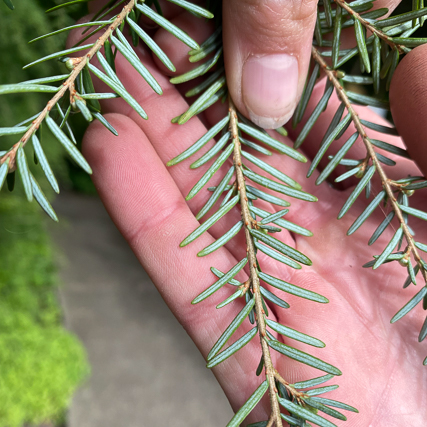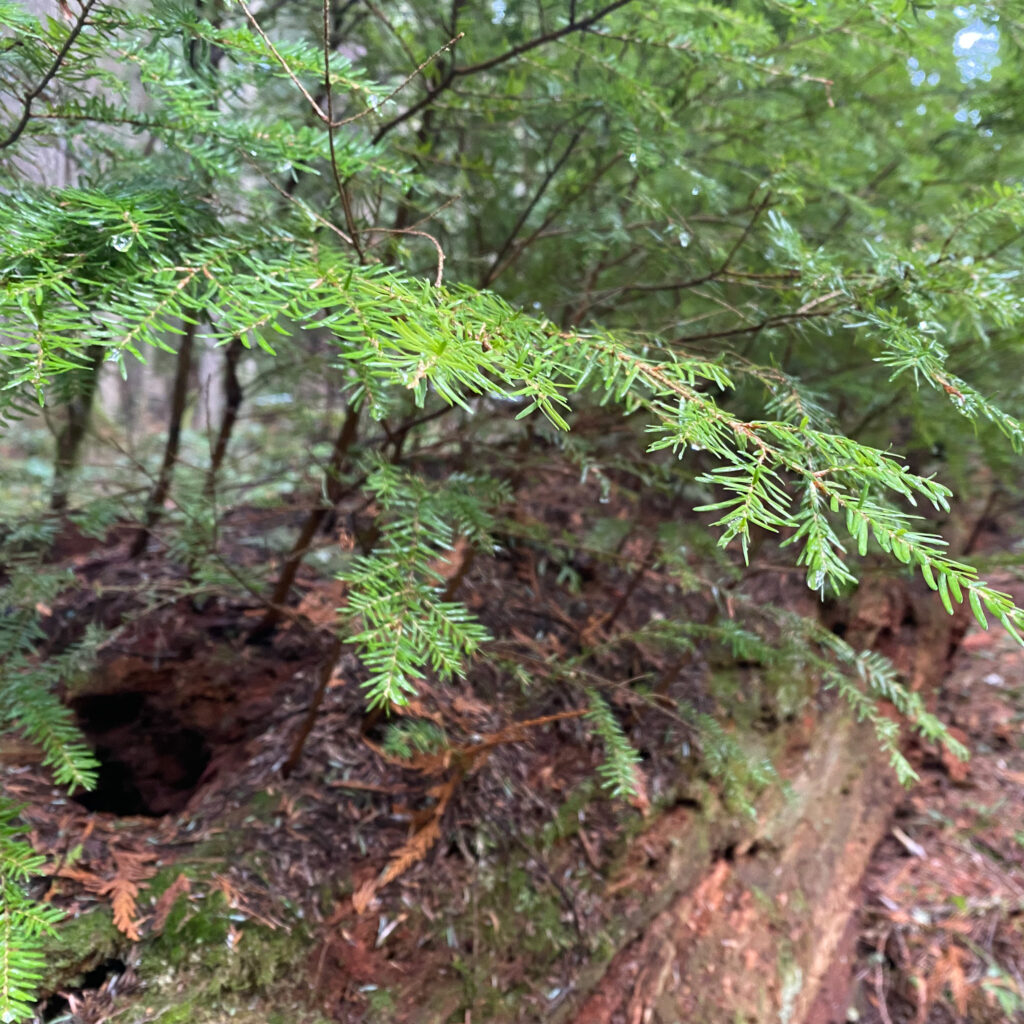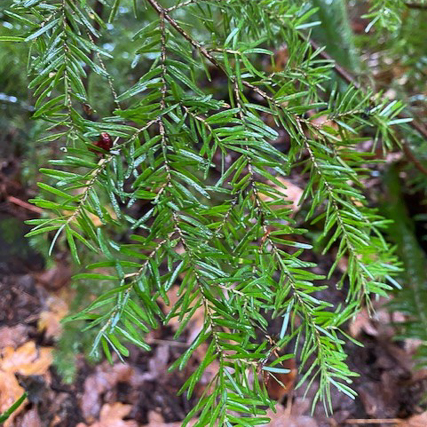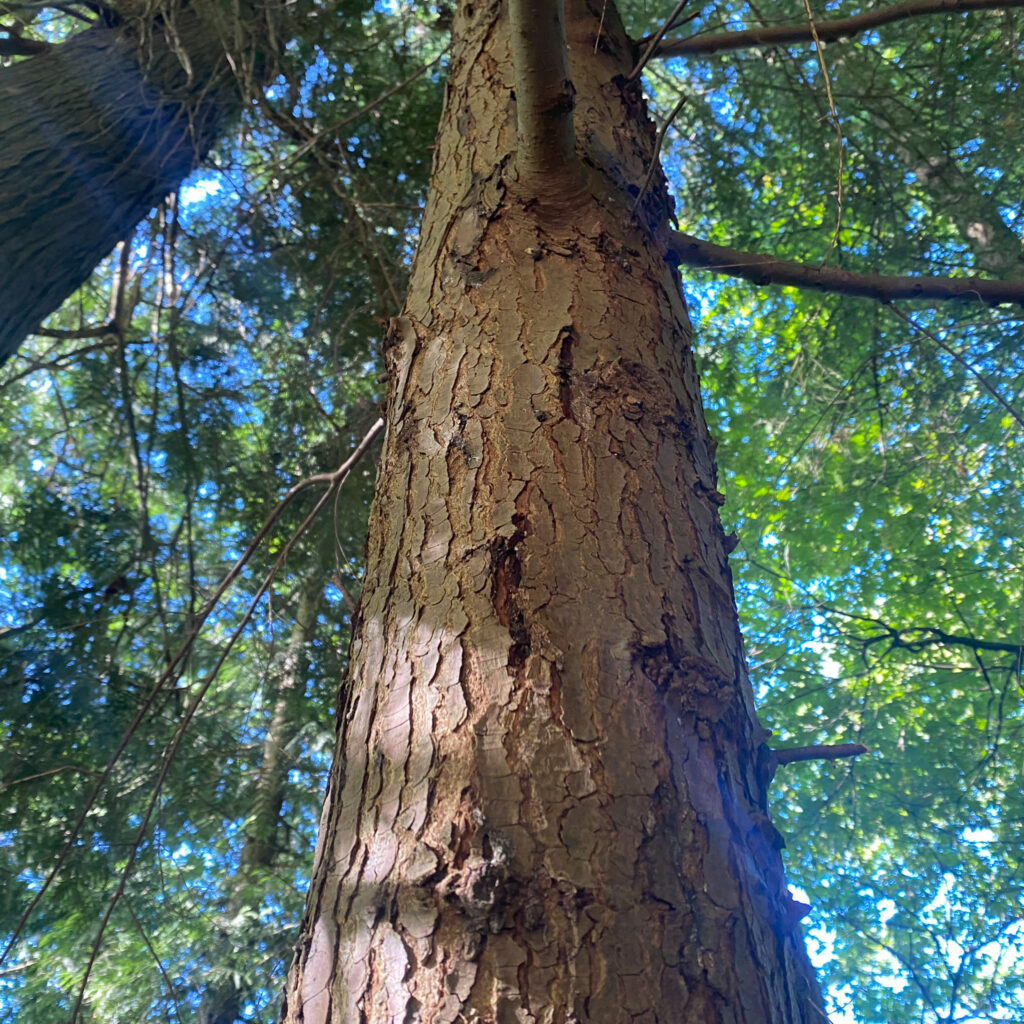fauntleroy tree walk
Western hemlock
lushootseed name:

latin name:
Tsuga heterophylla– Tsuga is the Latin word for “mother tree” and heterophylla is Latin for “different leaves” from the plant’s differing needle lengths
family:
Pinaceae, the pine family

Habitat
This species is found along the coast from Alaska to central California, mainly west of the Cascade Crest and in the Rocky Mountains of northern Idaho and Montana. It is so common here in Washington that it has become our state tree!
This species is the dominating tree of coastal forests in both British Columbia and Alaska. They are highly adaptable and can live in humid, moist to semi-dry conditions in the shade of other trees for many years. They will await the falling of that larger canopy tree and can then grow tall into that region of sunbreak.
These trees are very well adapted to growing in thick humus, or decaying matter, many times being found on a nurse log.

Identification
growth habit
Western hemlock is a tree that can grow up to ~200 feet tall. Height of this tree species typically depends on the amount of sunlight available in its canopy.

leaves
Rounded-tip and flat needles with green tops and white undersides. This tree gets its Latin name “heterophylla” from the differing length of needles that it has. Take a look at the branch head-on and notice the irregular, feathery appearance of the needle arrangement. While taking a look from afar, you will see that the top branch of Western hemlock is drooping and many of the tree branches follow that pattern as well.

fruits
Very small and numerous brown, papery cones that are a brilliant purple while immature.
flower
No flowers are present, as this is a coniferous species. This species has pearl-like, glossy white buds that turn into brown, papery pollen cones in April.

bark
Brown-red to gray with shallow furrows and small plates.

look-a-likes
You might mistake this plant with Douglas fir. Western hemlock has an overall “drooping look” while Douglas fir is more erect. Western hemlock needles are multiple different lengths, while Douglas fir are all the same length. Look for pearly white, rounded buds in the spring on western hemlock and sharply, pointed red on Douglas fir.
The easiest way to distinguish these trees is by looking at the cones-Douglas fir has larger, “mouse-tail” cones while western hemlocks have very small, flaky cones without bracts. Cones fall off in late summer, making the identification process more tricky.


Ecology
Western hemlock is not as resistant to fire as its counterpart Douglas fir, as this species has shallow roots and thinner bark that is more easily damaged in high heat. Where this tree shines is its association with decaying forest matter.
Western hemlock releases many, small cones that have papery-winged scales that can fly up to a mile, making it easily dispersed throughout the forest floor. These cones can sprout into saplings in thick humus, especially on that of a nurse log.
Nurse logs are created from decaying trees falling to the forest floor, becoming waterlogged, and in its decay-supporting many years of life. A thick layer of moss primarily takes over, creating a thick bed of soil for seedlings like western hemlock and its common associate huckleberry to take hold. Once these tree species start their growth, they gain an advantage over the other species in the forest. They grow from a higher vantage point, granting more sunlight. As the tree grows larger and the nurse log deteriorates, the western hemlock will form an arching “buttress” formation that will eventually fill in.
You may find this tree growing on past-logged stumps left within the forest. This decaying wood is rich in nutrients and mycorrhizal fungi connections that support the tree’s health. In turn, Western hemlock feed mycorrhizal fungi networks that feed the fruiting fungi bodies of mushrooms like Chanterelles and lobster mushrooms.
Western hemlock has an incredibly dense canopy, not allowing much life to grow in its shade. Many forest creatures such as leaf-mining moths, deer, small rodents, and birds feed on the foliage and seeds of this species.
Ethnobotany
Due to its quick-growth, this species has been heavily used in the lumber industry. Western hemlock has a high tannin content and has been used to water-proof basketry. It has also been used to make a red dye to color fishing nets to make them less visible. Another great use of this species in fishing is using boughs set in estuaries to catch nutritious herring eggs on its needles. The red dye has been used to color mountain goat wool and storage containers as well. Hemlock resin and oils are mixed to rid the scalp of lice.
Bark and resin is astringent and has been mixed with licorice fern, cascara, or red alder to treat hemorrhages. Spring growth-tips are high in vitamin C and make a great immune boosting tea or snack. Resin was mixed with deer tallow to make a salve used for chest colds or soothing sunburn. Western hemlock has been eaten as a winter staple food, pounded into cakes made from inner bark and served with oolichan grease and elderberries. Cooking bear meat in hemlock bark has been known to give the meal a delightful flavor.
